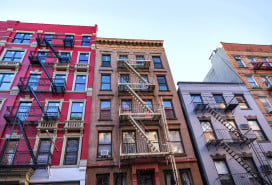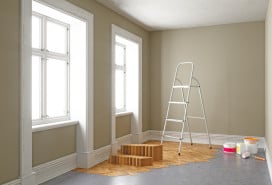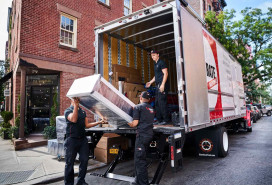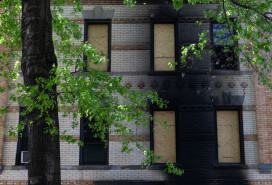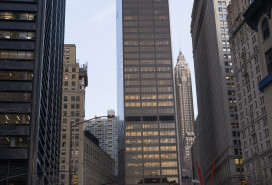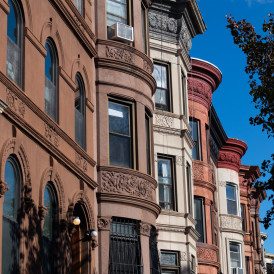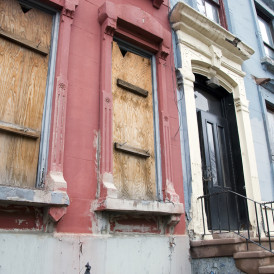What’s the best way to pack up my apartment for a move?
- Pack one room at a time; start with the kitchen and end with your bedroom and bath
- Protect fragile objects by wrapping them in packing paper and cushion with bubble wrap

Big Apple Moving can deliver reusable, all-purpose crates to streamline the packing process.
Big Apple Moving
Scoring a new place in New York City is no easy feat, so the last thing you want to do is spoil your new start by having a messy move. And that all starts with the packing job, which can make or (literally) break the entire process.
"Most of our customers do the packing themselves," said Dor Klein, chief operating officer of Big Apple Moving, a highly rated company that has provided local and long-distance moving services and secure storage options to New Yorkers since 1979.
Klein cited cost savings as the primary reason people take on this task, though mover beware: The responsibility for any broken or damaged goods due to improper packing is on you rather than being covered by the company's insurance. Good to know.
All the more reason to protect your prized belongings by packing them the right way. "Moving is all about minimizing the risk of damage, whether it's across the hallway or to another part of the city," Klein said.
Feeling overwhelmed? Read on for trade secrets to help you pack like a pro.
Stock up on moving boxes
Boxes are, of course, the default container for moving, and it's worth keeping any boxes from online orders for this purpose. One caveat: Don't use recycled boxes for fragile items. Better to buy dedicated moving boxes to ensure safe travel.
Before you head to Home Depot or a local packing supply store, take inventory of the contents of your move. Medium-sized boxes can handle the bulk of your stuff, but you'll need small "book" boxes for heavier items (including small appliances and electronics), while larger boxes are convenient for lightweight bedding, towels, and stuffed animals.
Specialty wardrobe boxes are great for hanging clothes; so-called dish packs are reinforced to protect dishes and other fragile items. Moving crates are a must for valuable artwork and heavy mirrors.
Buy only heavy-duty packing tape to seal up all the boxes.
Or skip the guesswork by renting reusable containers, which come in a one-size-fits-all package. "When booking your move with us, we can provide plastic bins that you rent and return—they are cheaper, more durable and sustainable, and stack for space-saving efficiency," Klein said.
Whichever container you are using, you'll need safeguarding supplies for fragile and delicate items. Klein recommended buying rolls of tear-free, ink-free, non-abrasive packing paper for wrapping and using to stuff boxes, along with bubble wrap for extra cushioning. Other options for the latter include extra packing paper, recycled newspapers, old towels or blankets, and packing peanuts.
Stretch wrap (or standard shrink wrap) is also handy for sealing loose items—think flatware in a drawer insert—while in transit. Have masking tape on hand for securing the wrapping materials.
Follow general best practices
Pack room by room, starting with the kitchen and ending with your bedroom and bathroom.
When packing each space, begin with less frequently used items and save those you will need to use up to moving day for last. In a similar vein, pack out-of-season clothes, footwear, and bedding first.
"Label everything so movers know exactly where everything goes to avoid slowing down the move and making unpacking extra challenging," Klein said. Tip: Write the name of the target area on the sides of the box so it is visible when stacked.
Never pack personal items like your passport and laptop or particularly sentimental objects, such as heirloom jewelry. Bring these with you.
Take special care of fragile objects
Books can go directly into the moving boxes, with a few tricks: Place heavier and bigger books horizontally on the bottom of the box, stacking lighter and smaller ones on top.
For fragile goods, first wrap each one in packing paper, tucking the ends inside mugs, glasses, pitchers, and vases, then secure with masking tape. Be sure to double-wrap wine and other delicate glasses, wrapping the stems separately for added protection. Wrap plates and bowls individually, too; do the same for pots and pan lids made of glass.
Place a layer of cushioning material on the bottom of the container before adding the wrapped items, nesting bowls upside down and stacking plates. Rest wine glasses in the top half of boxes to avoid crushing them. Fill any gaps as you go with balled-up paper, then add another layer of cushioning on top. Seal the box securely with packing tape, then label the box, marking it "fragile" along with the destination.
Follow the same process for small electronics, mirrors, picture frames, and artwork as well as lamps and shades (separately)—always wrap these in paper and then bubble wrap.
Consider leaving rare or valuable artwork, heavy mirrors, and musical instruments (or a prized wine collection) to the pros. "We offer expert handling by specialists, and the items will be insured by the company in case of damage," Klein said.
Planning your next move? Big Apple Moving provides top-notch service backed by our 100 percent satisfaction guarantee and a team of skilled movers for a pleasant, comfortable experience. Visit the website or call (212) 365-0707 for an instant price quote.





